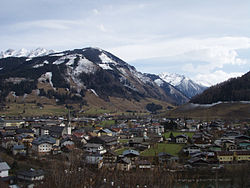Bruck an der Großglocknerstraße
| Bruck an der Großglocknerstraße | ||
|---|---|---|
 |
||
|
||
| Location within Austria | ||
| Coordinates: 47°17′00″N 12°49′30″E / 47.28333°N 12.82500°ECoordinates: 47°17′00″N 12°49′30″E / 47.28333°N 12.82500°E | ||
| Country | Austria | |
| State | Salzburg | |
| District | Zell am See | |
| Government | ||
| • Mayor | Herbert Burgschwaiger (SPÖ) | |
| Area | ||
| • Total | 45.74 km2 (17.66 sq mi) | |
| Elevation | 756 m (2,480 ft) | |
| Population (1 January 2016) | ||
| • Total | 4,611 | |
| • Density | 100/km2 (260/sq mi) | |
| Time zone | CET (UTC+1) | |
| • Summer (DST) | CEST (UTC+2) | |
| Postal code | 5671 | |
| Area code | 06545 | |
| Vehicle registration | ZE | |
| Website | www |
|
Bruck an der Großglocknerstraße is a municipality in Zell am See District, in the state of Salzburg in Austria.
Bruck in the historic Pinzgau region is situated in the valley of the Salzach river, at the northern entrance to the Grossglockner High Alpine Road running up to the High Tauern mountain range and the Alpine crest. Neighbouring municipalities are Zell am See, Taxenbach, Fusch, Kaprun, and Maria Alm.
The municipal area comprises the cadastral communities of Bruck, Hundsdorf, Reith, and Sankt Georgen. Local villages are: Brandenau, Bruck, Fischhorn, Gries, Hauserdorf, Hundsdorf, Krössenbach, Niederhof, Pichl, Reit, Sankt Georgen, Steinbach, Vorfusch, and Winkl.
Evidence points to a settlement as early as the Bronze Age and Hallstatt period. The Illyrians and Celts settled here, as did the Romans from about 15 BC. In the course of the Migration Period and the fall of the Roman Empire, Bavarians settled and mingled with the local population. The first mention of Prugg im Pinzgrey in the Archbishopric of Salzburg occurred in a 1227 deed.
At the same time, the castle of Vischarn first appeared in the records, initially held as a fief by the Lords of Goldegg, later a possession of the Bishops of Chiemsee. The building was purchased by Princess Sophie of Liechtenstein and her brother Prince Johann II in 1862, who had it rebuilt in a Neo-Gothic style according to plans designed by Friedrich Schmidt. Again rebuilt after a blaze in 1920, it was seized by the Nazi SS organisation in 1943 and temporarily served as a subcamp of Dachau concentration camp. In May 1945, American troops arrested Hermann Göring here before he was taken to Camp Ashcan.
...
Wikipedia


